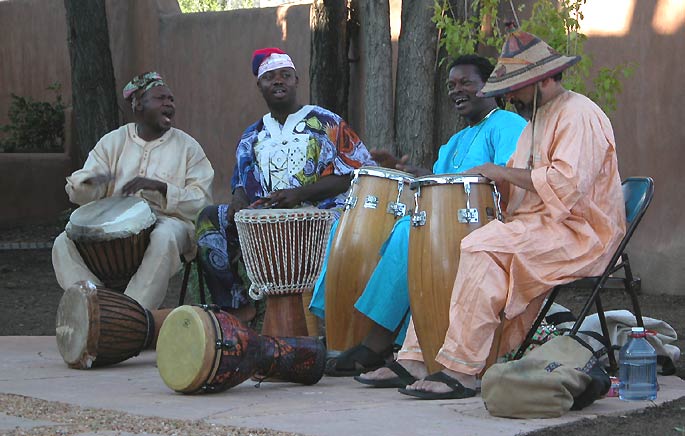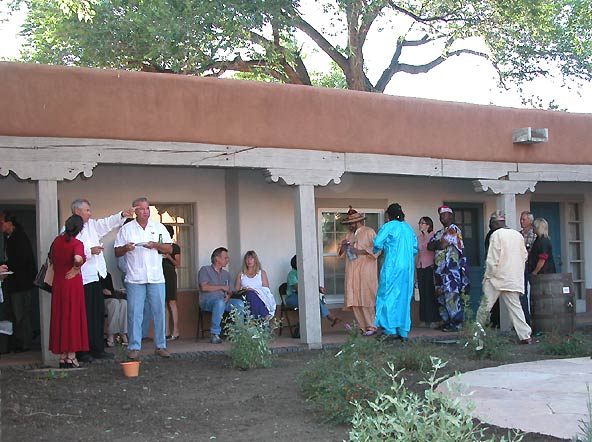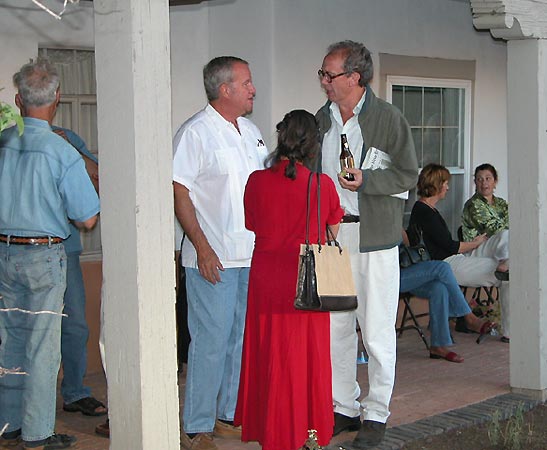Written by Michael Auliso and republished here with his permission.
This year in Santa Fe there were even more tribal art venues than last year making it challenging for visitors to take it all in. There was a third satellite show added called “Second Site” as well, as the Sweeny Center Show and the Indian & Tribal Show. The Historic Indian and Tribal show promoted by Barry Cohen was no longer held at the El Dorado hotel as in previous years, but was located 4 miles from the Plaza, at the Shellaberger Tennis Center on the Santa Fe College Campus. The Ethnographic Show at the Sweeney Center was in its 21st consecutive year. In addition to all that, there was even a Native American Indian auction held at the La Fonda Hotel! These additional events however did not attract more customers and in fact seemed to have a “dilutive” affect on the Tribal market all around, in that approximately the usual number of customers were sparsely distributed over all the shows.
A highly anticipated event was Tad Dale’s opening night of new acquisitions (Located at the corner of W. San Francisco Street ). It was a huge success with festive atmosphere, marvelous African Drummers, gourmet food and the superb tribal art that “TAD” is know for. (See photos at the end of the article) At the William Siegal Gallery, Bill Siegal who generally sells museum quality Pre-Columbian Art and Textiles expanded the galleries interest by featuring an exhibit of African Art from the Kevin Conru collection.
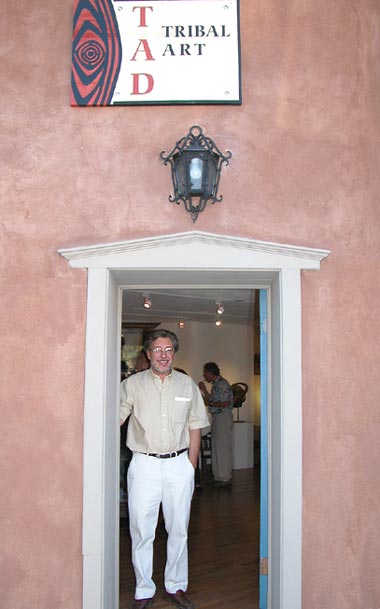
Tad Dale in Front of His Gallery
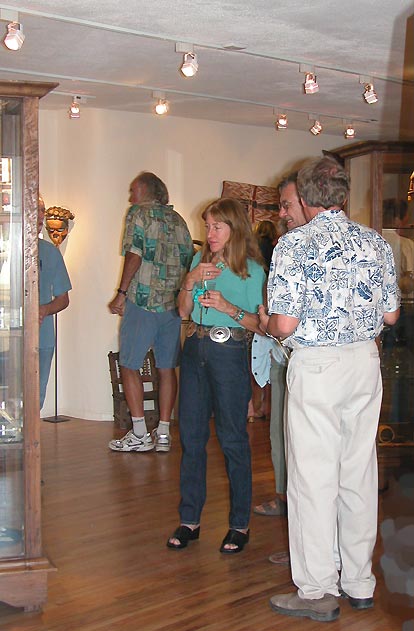
Tad’s Opening Night of New Acquisitions
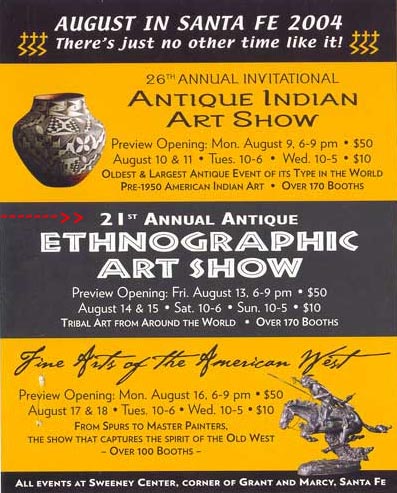
Sweeney Center :
The Whitehawk show promoters will be temporarily losing the Sweeny Center location while the two level structure is demolished and reconstructed for optimization with underground parking. I’ve heard it will be reopened as soon as next year, or as long as 3 years. If construction is delayed for several years, it is theorized that the Shellaberger Tennis Center show would become the dominant show. The Sweeny promoters find themselves at a crossroads where they can either decide to continue with the same composition of dealers or reinvent the Ethnographic show to be more competitive. More specifically perhaps the question they face is whether to make it an “Ethnographic Show” or a Spanish Colonial/ Jewelry show. The last genre’ making up the bulk of the existing exhibitors..
This year several dealers jumped ship and switched to exhibiting at the Tennis Center Location. There are now just about 8 loyal dealers left at Sweeney, who help elevate the quality of the Tribal offerings at the show. I must say they are like a beacon of light in an otherwise fog of lesser material, to most tribal enthusiasts. I overheard several attendees mention that the this year’s show had an obvious lack of exciting pieces.
On the one hand because this show has been historically popular and well attended, it has a “charged” feeling, in contrast to the Tennis Center Show. The diversity in dealers and spectrum of material draws an equally diverse crowd which overall is very positive. There is always excitement and enthusiasm when the show opens, probably because the prospect of finding a deal is good; although the pickings aren’t what they once were, great deals still turn up. For example, one dealer in the front of the show had an average looking Yaka figure from the Congo with upturned nose and blue pigment. It eluded identification by most everyone. Then an astute dealer snapped it up, as on closer examination, he recognized it as a rare and early type of Dayak Figure from Borneo !! Needless to say a “price correction” followed that purchase.
TAD Tribal Art (Santa Fe NM) again had a theme booth which was devoted to “Faces”. All of Tad and Sandy ’s pieces had distinctive faces whether it was a betel nut mortar, a staff, or a mask. Thomas Murray (Mill Valley, CA) had an artistic display of high quality Indonesian and Asian Art. The masterpiece in the show probably belonged to Joel Cooner (Dallas, TX)who had a phenomenally large and beautiful woven Mambila wicker shield accented with geometric designs. This is of course subjective but the shield was amazing! By the end of the show Joel had sold it.
As mentioned in last years review, Santa Fe is a tricky place to exhibit African Art (especially sculpture and masks). It seems a portion of the market here doesn’t differentiate between decorative newer pieces, and authentic antique pieces, not really understanding the prices differences. I’m only briefly mentioning this to help spare visiting dealers from a disappointing show experience and for Lovers of African Art who may find the pickings slim. The exception to this would be Tad Dale and Bill Siegal who have local galleries, authentic pieces and established clients. They do have considerable success selling African Art.
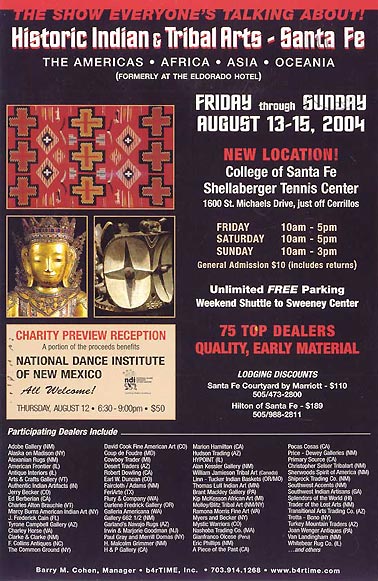
Shellaberger Tennis Center :
This show had a total of 77 dealers. This is mostly a high quality antique Native American show with a handful of Tribal Dealers. Cohen was more successful in luring established Native American dealers than tribal dealers. There was still a spattering of Tribal Objects. Generally everything at this show was priced at full retail, which is fine with many collectors. Several dealers told me that feedback they received from visitors was that the show felt too high end and somewhat intimidating.
Several quality dealers were conspicuously absent this year, including Mark Blackburn “Mauna Kea Galleries” ( Hawaii ), Michael Hamson ( Los Angeles ) , and Charles H. Gerhardt ( Ohio )
The input I received from most dealers was that attendance was low. The number reported to me by a show employee was approximately a 1000 people. That may seem like a lot but the show often seemed empty. Some dealers were optimistic saying it was the first show at this location and that was to be expected. Unlike the New York Tribal Show, the attendees at this show were not just casual lookers but were comprised of serious collectors. Most of the dealers that did report sales, say that it was either from other dealers however, or regular customers. Dealers reported to me that attendance seemed to plummet after the Friday night opening. This is perhaps because customers were holding off making purchases to see if there were equal things at better prices to be found at the Ethnographic Show at Sweeny Center .
The exhibitors said the setup was easier. They appreciated the new clean bright location which had an interlocking rubber floor and good lighting. In spite of the brightly illuminated Tennis center interior, the show didn’t feel cheerful and actually had a decidedly negative or depressing vibe about it…. This is worth noting since it was so apparent. Perhaps the competition for Native American customers caused some dealers to act in an unprofessional manner casting tension over the show? Possibly the comraderie that exists between the tribal art community in general, is not the rule amongst the Native American Dealers. Fierce competition may play a large role in this situation. One other criticism is that there was little if any seating area. The snack bar had no more than 8 chairs which was not enough for a show of that size.
Unlike the vetted Caskey Lees Shows, this event was not vetted. Consequently not all of the material was authentic. There were 3 or 4 vendors selling dubious African Art which obviously must have frustrated the dealers who were selling authentic pieces like Peter Boyd ( Seattle ), Bob Dowling ( San Francisco ) and Kip McKesson ( Michigan /Tanzania ).
TRIBAL MATERIAL:
Casey Conway had a large booth with a collection comprising Tribal, Native American and Pre-Columbian material. Of note, he had an attractive carved New Ireland horizontal frieze from the Peter Hallinan Collection.
The only Asian and Indonesian Dealers were John Struzinski–Primary Source and Eric Farrow( San Rafael , CA ). Eric had a broad selection of Tribal Weapons and Indonesian Art. He had three traditional old carved Dayak “work boards” as well has two large and impressive New Guinea Highlands War Shields. Bob Dowling had a large selection of quality 19th c. Philippine figural spoons. Kip McKesson’s booth featured three fine early woven Tutsi Panels. Common Ground ( New York City ) displayed a fine Dan Bassa Mask priced at $20,000.
NATIVE AMERICAN:
If you’re an advanced collector of Native American Art you would surely enjoy this show.
The legendary deified dealer George Terasaki of New York was seen walking around with his hand folded behind his back.
Rumor had it that Veteran dealer H. Malcolm Grimmer had sales of 7 figures during that week of the show. He was no doubt one the main “anchors” for the entire show. In his booth he had sold tags on a Hupa Woman’s Dance Apron and a Sioux Bow and arrow quiver. He also had a stunning Comanche woman’s dress priced at $85,000, and a rare Ghost Dance shirt for $165,000.
Myers and Becker Art of the Americas (NY, New York) had a terrific selection of Eskimo Walrus Ivory smoking pipes. Alaska on Madison (NY, New York ) had fine selection of Northwest Coast Halibut hooks, Eskimo Ivory Pipes and a Zambian Mask stuck in. Jackson Street Gallery (Seattle ) displayed a Large Nootka mask for $14,000 and a Northwest Coast Salmon Club for 24,000 to name a couple pieces.
Interestingly there was one vendor who was selling baskets which were handmade in Pakistan . Many of them looked exactly like desirable Native American baskets, yet they were a fraction of the price, newly made and varied in the materials used. To an untrained eye, however, they looked great and could pass for the real thing. On the topic of baskets…there were loads of baskets and after a while, they seemed to have a hallucinatory affect on the observer.
Trotta-Bono (Shrub Oak NY), Displayed a wide range of beautiful pieces which included an Otter Effigy ball head club with handsome maple burl grain and terrific balance. I especially took note of his Aleut Bent wood hunting hat, from the Bering Sea which was priced at $40,000. Ramona Morris Fine Art (Delaplane, Virgina) featured an Attractive 19th century North West Coast Wood Plate with Dragon Fly Motif. Merrill B. Domas and Paul E. Gray (Old Chatham, NY) Had the most dramatic if not the best Arctic piece in the show, which was a large Eskimo Bering Sea mask with dark patina with beautifully carved interlocking wood teeth wearing a sun visor for $37,500.
Second Site:
This was a small show with approximately 20 dealers selling newer, and low to middle quality material. This was a good venue especially for collectors on a budget looking for value, and there were deals to be found. The opening of the show saw frenzied buying especially at Leslie Martin’s booth where customers were grabbing from each other, keeping Rebecca Martin very busy! The best pieces were cherry picked in the first 24 hours. So next year get there early!
I think I speak for everyone in the Tribal art community in extending our thanks to the participating dealers and to the Show promoters for providing an organized arena for these tribal art events. They benefit not only those involved but the tribal art world in general.
Courtyard Photos from Tad Dale’s Opening Night of New Acquisitions
